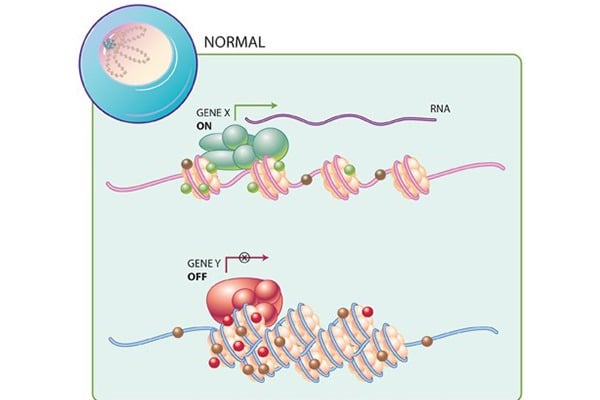Study defines differences among brain neurons that coincide with psychiatric conditions

It’s no surprise to scientists that variety is the very essence of biology, not just the seasoning, but most previous studies of key brain cells have found little variability in a common cell process that involves how genetic information is read and acted on.
The process, called epigenetics, involves chemical or structural “tweaks” to gene activity that don’t affect the underlying genetic code itself, but do affect when and how a gene becomes available to be read for its protein-encoding instructions. When epigenetic changes strike at the wrong time or place, the process turns genes on or off at the wrong time and place, too.
Now, in a new study focusing on four regions of normal human brain tissue, Johns Hopkins scientists have found about 13,000 regions of epigenetic differences between neurons in different brain regions that vary by at least 10 percent. Using whole genome sequencing and computational statistical tools, they also found that the location of those epigenetic changes — covering about 12 million bases in the genome — co-locate with the genetic signal contributing to addictive behavior, schizophrenia and neuroses such as biopolar disorder.
“We believe we have figured out what parts of the neuronal genome are epigenetically different among these four brain regions,” says Andrew Feinberg, M.D., the Bloomberg Distinguished Professor of Medicine, Oncology and Molecular Biology and Genetics. “And these areas are enriched with inherited genetic variants linked to certain psychiatric conditions.”
Scientists have long suspected that epigenetics plays a significant role in psychiatric conditions, other neurologic diseases such as Alzheimer’s, and a long list of other human ailments, including cancer. The current study does not definitively prove an epigenetics link to psychiatric conditions, but provides a road map to further study epigenetic diversity in the gene locations identified by the Johns Hopkins team, Feinberg says.
“We do know that both epigenetic and genetic changes contribute to the problem of cells not doing what they’re supposed to do,” adds Feinberg, who has studied epigenetics for decades. Results of the study are described online Jan. 14 in Nature Neuroscience.
Biostatistician Kasper Hansen, Ph.D., who co-led the study with Feinberg, says one of the main differences between their study and previous attempts to look at epigenetic diversity is that the Johns Hopkins scientists used a strong experimental design focused on different cell populations, including neurons. Other studies did not separate neurons from brain glial cells, which support neurons, acting as scaffolding, cleaners and nutrient suppliers.
The Johns Hopkins scientists, including first authors Lindsay Rizzardi and Peter Hickey, began their research with 45 brain tissue samples taken from six people (three males and three females, ages 37–57) who were not diagnosed with psychiatric or neurologic conditions and, upon their death, had donated their brains to biobanks at the National Institutes of Health and University of Maryland.
The samples were taken from four regions of the brain: the dorsolateral prefrontal cortex, which controls decision-making and social behaviors; the anterior cingulate gyrus, known for its link to emotions and behavior; the hippocampus, which is responsible for learning and memory; and the nucleus accumbens, the site for processing reward behavior. By comparing samples from the same individual across different brain regions and cell populations, it is possible to rule out the confounding effect of genetics and many environmental exposures, such as smoking, says Hansen.
The scientists purified the brain tissue samples to isolate neurons and glia, sequenced the neurons’ genome and compared the sequencing results of neurons in each brain region. Looking at the distribution of epigenetic changes across the genome, the scientists found more epigenetic diversity in 12 million base pairs (out of 3 billion) of the genome than what would normally occur in those regions by chance alone. They found that most of the differences in epigenetics occurred in neurons of the nucleus accumbens, the brain’s reward center.
Using statistical tools to evaluate the genomic sequencing results, the researchers found that at least one of eight types of epigenetic changes was positively correlated with known genetic code changes among nearly half (13 of 27) of traits linked to heritable forms of addictive behavior, schizophrenia and neuroticism. Epigenetic changes were not linked to genetic differences among heritable, non-brain-related traits such as body mass index and height.
Hansen, who is an associate professor of biostatistics at the Johns Hopkins Bloomberg School of Public Health and McKusick Nathans Institute of Genetic Medicine, explains that the strong experimental design helps eliminate differences between individuals by comparing multiple samples from different brain regions from the same individual. “Furthermore, the strength of the genetic association is also determined by existing results on the genetic architecture of these traits, which have been established from tens to hundreds of thousands of samples,” says Hansen.
“Epigenetic changes may alter cells’ identity as well as their function,” suggests Feinberg, who also is a professor of biomedical engineering, biostatistics and psychiatry and behavioral science at Johns Hopkins. “To reveal how epigenetics is linked to psychiatric conditions, the next step is to develop customized genomic arrays that capture the areas of the genome that we identified and compare them to more samples of people with and without psychiatric disease.”
The Johns Hopkins team of researchers also includes Varenka Rodriguez DiBlasi, Rakel Tryggvadóttir, Colin M. Callahan and Adrian Idrizi.
